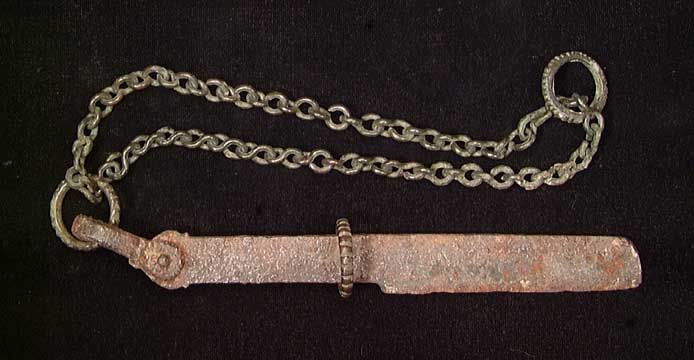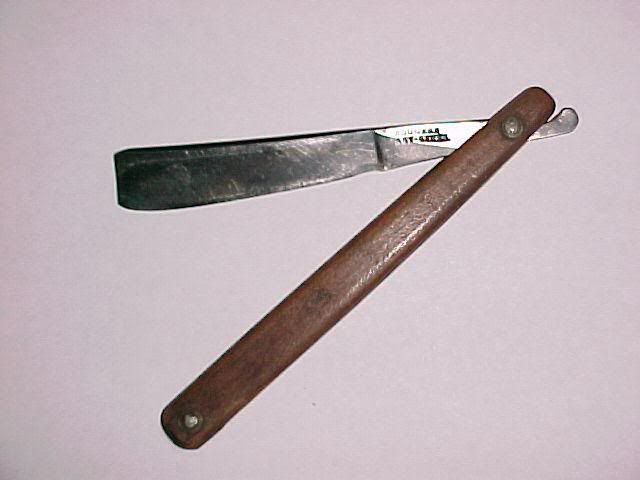Results 1 to 10 of 18
-
06-11-2008, 03:36 PM #1
 The history of the straight razor
The history of the straight razor
I am told that the modern stainless steel straight was not first available until the mid 1950s. When did the straight razor take its present form? What would George Washington's straight razor look like if I saw it? How did Martin Luther shave (straight? coal?) If Joan of Arc saw some of the men in her army shave, what would she have seen? How far back in history do I have to go before the straight razor is yet to be invented?
-
06-11-2008, 03:53 PM #2

You'll have to go to the Donald W Reynold museum at Mt. Vernon to see George Washington's razor

I imagine the European straight razor began as the sort of straight razor we are shaving with now but without the neat little folding handle. I found a photo of one such tool that was dated to 1000 to 1500 years ago. I wish I knew what the european monks were using in the 15th century. The razor below is for sale here. Maybe we should pool together and buy it for the SRP museum?

Last edited by hoglahoo; 06-11-2008 at 04:26 PM.
Find me on SRP's official chat in ##srp on Freenode. Link is at top of SRP's homepage
-
The Following 2 Users Say Thank You to hoglahoo For This Useful Post:
clrobert60 (06-11-2008), geoffreyt (06-11-2008)
-
06-11-2008, 05:30 PM #3

People have been using the sharpest thing they had available since prehistoric times, although some cultures have preferred to pluck or burn off the whiskers. The two innovations that produced the kind of straights we are using were hardened, tempered steel and the hollow grind, both coming from Sheffield in the mid-1700's. Stainless wasn't invented until well into the 20th century, and didn't get used for straights until the '50's or so as you say.
Before about 100 years ago or so people didn't shave very frequently, and even then it was usually left up to professional barbers and not done in the home, so you probably wouldn't have seen Joan of Arc's soldiers or the medieval monks shaving themselves. (I think the word "barber" comes from French "barbier", roughly meaning "beard guy," so even though we think of a barber today as someone who cuts hair, traditionally it was someone who gives you a shave.) I presume the barbers would have used one-sided knife-like razors of whatever material was in vogue for making the sharpest blades at the time. I think it started to become popular for people to keep their own razors and shave themselves at home some time around the 1880's or so. So if you thought by straight razor shaving you were joining in on an ages-old ritual, you kind of are, but... not really.
In Ancient Rome, it was fashionable to get your whole body shaved while you were at it! Emperors are said to have suffered chronic razor burn over their bodies because the slaves who shaved them would naturally try to give them extra-close shaves (and maybe because their blades weren't as good as ours).
-
06-11-2008, 06:15 PM #4

This ain't that old but not new either

 Be careful how you treat people on your way up, you may meet them again on your way back down.
Be careful how you treat people on your way up, you may meet them again on your way back down.
-
08-24-2010, 03:20 PM #5Junior Member

- Join Date
- Aug 2010
- Location
- Oisterwijk, the Netherlands
- Posts
- 4
Thanked: 8
I just stumbled into this forum, so please forgive my tardiness concerning the following information.
In 15th century Europe, straight razors were used that didn't differ much from ours, including the hinge. See the pictures for an example that was found in a 15th century waste-pit in the city of Deventer. There's also a contemporary descriptive handwriting of razors that says:"Die sceersen om te barbieren wt Almaengien getekent metter sterren ende metter ekelen zyn de beste."
In English:"The razors (or blades) for shaving (barbering) from Germany marked with stars or with acorns are the best."
The star can be seen in the picture, just below the crook in the back. Like the acorn, it's a smith's mark and a sign of quality.
The dimensions of the blade are:
total length: 200 mm
blade lenth: 104.5 mm
blade width: 24.2 mm
blade thickness at the back: 8.8 mm
It's made of non-stainless steel, the same as that used for making swords. Men did shave themselves, but only when necessary. Monks shaved eachother and french knights shaved before battle. That might seem strange, but keep in mind that the enemy would slice your throat if they captured you and you didn't look like you're worth very much. Better have a shave and a clean shirt... Medieval folk shaved regularly up to the 16th century, when beards came info fashion again. During the middle ages (500-1500), they shaved according to fashion. Some times it was considered barbaric in some places and manly in others to wear a beard (8th century Scandinavia: beards are hip, 8th century Europe: beards are barbaric... I wonder why).
Barbers were professionals that got organised in guilds from the 14th century onward. They were shavers, wound-binders, tooth-pullers (which was often a public spectacle) and the lowest rank of what one might call doctors. To enter a guild, a barber had to craft his own razor and grind it sharp enough to cut through a belt of a certain thickness and width.
The wear and oxidation of the blade indicates that the steel was twisted and folded, hammered into shape, then heat-treated. There's no mention of a straight or hollow grind, but I hope I've given you some helpful information. A traditional smith is making a copy for me, I'll let you know how it goes...Last edited by Andress; 08-24-2010 at 04:12 PM.
-
The Following 7 Users Say Thank You to Andress For This Useful Post:
eblueaxe (01-01-2014), FTG (08-25-2010), halexander92 (08-25-2010), Havachat45 (11-03-2012), markevens (08-24-2010), scrapcan (08-27-2010), Str8nDE4RAD (09-08-2010)
-
08-24-2010, 03:44 PM #6

Something like a straight razor has been used for over 4000 years. Archaeologists regularly excavate razors from ancient sites. Some were made of flint or obsidian. From about 2700-1000 BC, the only wide-spread metal in use was bronze, and yes, bronze razors have been found. On another thread here I've posted a few pages from a volume of history dealing with the Bronze Age, in which the writer discusses shaving and provides a plate with about a dozen drawings of razors found in archaeological excavations.
If I can find a link to that thread, I'll post it.
-
08-24-2010, 04:31 PM #7

It seems most stainless razors are from the 50s and late 40s however there are some from earlier times. Stainless has been known from the early 20th century but was probably very exotic stuff and too expensive and the alloy was different. The same as Aluminum. At one time an aluminum cup was worth more than Platinum.
No matter how many men you kill you can't kill your successor-Emperor Nero
-
08-24-2010, 08:08 PM #8

This site gives a nice intro to razor history.
Straight razor history
Welcome to SRP! What book is that you are getting the pics and information from?
-
-
08-24-2010, 08:32 PM #9Junior Member

- Join Date
- Aug 2010
- Location
- Oisterwijk, the Netherlands
- Posts
- 4
Thanked: 8
Hi Mark,
thanks for the welcome and the link!
The book is: "Het Nederlandsche Interieur in de Late Middeleeuwen (1400-1525)" (English: The Netherlands Interior in the late Middle Ages (1400-1525)). It mainly describes catalogued interiors from the 15th century, like weddinggifts, execution-sales, auctions and to my surprise, finds like this one!
It's out of print and I had it on loan from an acquaintance. The blade's a museumpiece in Museum De Waag or Historisch Museum, in Deventer, the Netherlands. This is a link to the museum's collection, specifically the razor: http://www.collectiedeventermusea.nl...ation=centrale
This is the main site for the museum: Historisch Museum Deventer
It's nice to see this topic come back to life since 2008!
-
The Following User Says Thank You to Andress For This Useful Post:
eblueaxe (01-01-2014)
-
08-24-2010, 08:40 PM #10

Here's a thread featuring a 3200 year old razor and an attached article (down the thread a bit) describing razors from before 1000 BC. I don't know if they all qualify as "straight" razors, but they are definitely not safety razors!
Ultimate Restoration Project
-


 18Likes
18Likes LinkBack URL
LinkBack URL About LinkBacks
About LinkBacks






 Reply With Quote
Reply With Quote




